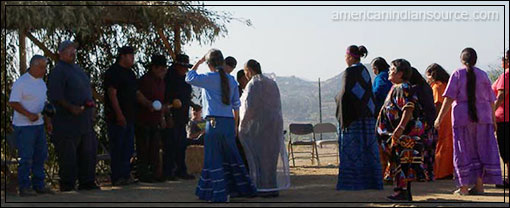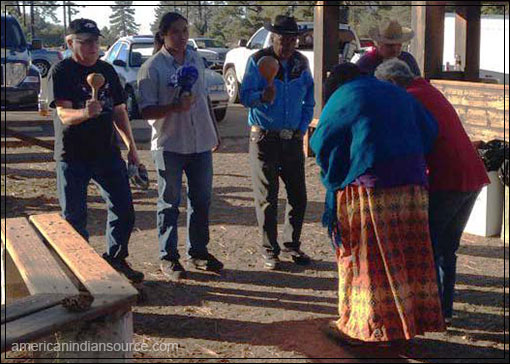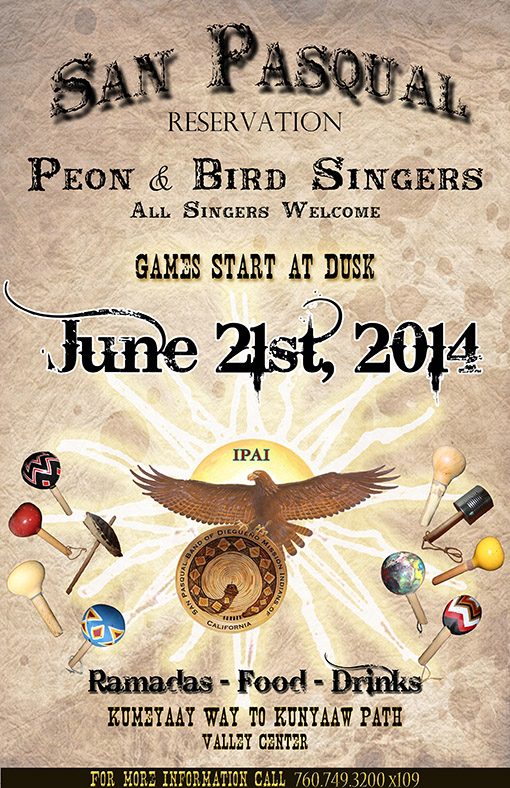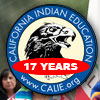 |
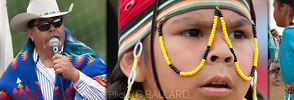 |
 |

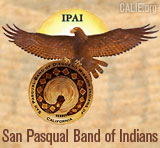
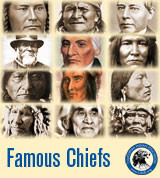
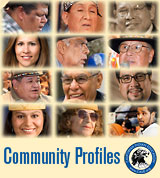

Publishing Corner: Indian Community: Science & Wonder Indian Heros: California Indian Art: CALIE Library: Academic Financial Aid: Tribal Governments: Indian Gaming: |
PEON & BIRD SINGERS EVENT
The San Pasqual Ipai at the base of Palomar Mt. will hosted its annual Bird song and Peon contest on June 21, 2014. The tribal event is open to the public.
PLAY PEON GAMES in San Diego:For Ipai and Kumeyaay Indians, who live in San Diego County and in Baja California, the perpetuation of traditional songs is extremely important to the maintenance of cultural identity. Traditionally, there was the oral tradition language and songs conveyed the telling of journeys, historical events, the creation, and valor were an integral part of traditional Kumeyaay life, conveying traditional knowledge, history and social values.
Historically the ancestors of the San Pasqual Indians lived for tens of thousands of years in the valley carved by the Santa Ysabel Creek, where modern Highway 78 now winds, near the present site of the San Diego Zoo’s Wild Animal Park. After the invasion of the Spaniards and the establishment of Mission San Diego de Alcala in 1769, many Kumeyaay either left or were forced out of their ancestral homes, and were converted to Christianity. For most San Pasqual Indians, adopting parts of European culture did not mean the abandonment of Kumeyaay ways. Spanish religion, customs and language were merely added to the Kumeyaay traditions developed over thousands of year. When the United States declared war on Mexico in 1846, forces under General Stephen Watts Kearny were sent across the desert to capture San Diego. He arrived with 100 men outside the village of San Pasqual in a driving rainstorm, hoping to eventually link up with U.S. naval forces arriving in southern California. Kearny found and attacked a similarly sized Californio force under Andres Pico. After Kearny’s men united with US Naval forces at San Diego San Pasqual leadership lent the Americans desperately needed horses and oxen to pull artillery and supplies in their drive to capture Los Angeles, which was achieved in January, 1847. The rejection of the 18 negotiated treaties including the Treaty of Santa Ysabel marked the beginning of an extremely difficult era for the San Pasqual Indians. Illegal outlaw squatters and Sons of California poured into the San Pasqual Valley and surrounding region, the creek making the land highly desirable for farming and cattle rearing. To protect the San Pasqual people, President Ulysses S. Grant created a reservation for them by executive order in 1870, but the order was rescinded in 1871 in response to greedy settler’s demands.
Like their forefathers, the San Pasqual people adapted themselves to the new world they were forced to live in, learning English and developing new skills. Many took Mexican or even Anglo spouses, adding to the cultural heritage of the community. In spite of these adaptations, band members maintained many of their social and cultural ties. Fiestas celebrating the saint’s day of San Pasqual were held at the pueblo’s original chapel or other Indian villages. Some maintained the traditional Kumeyaay language and cultural traditions.
Today, the most commonly known song cycle is that of Tukuk Bird Songs, which are used for ceremonial and entertainment. These songs have allowed the Kumeyaay to maintain a connection with their cultural past despite the contact with and destructive influences of European intrusions. Other song cycles, which include wildcat and salt dances and perhaps 10 other regional variations are still sung. Specific rules govern the way in which they are sung and presented. Because of the quantity and length of these songs, it takes many years of practice and imitation to learn and master their presentation. Jon Meza Cuero is possibly one a few Kumeyaay in the United States who knows the wildcat cycle of songs, one of the many cycles of songs sung by the Kumeyaay. Born in Potrero, California, Jon was raised by relatives on the Mexican side of the border after his mother's death when he was two years old. He returned to the San Diego area when he was about 20 years old. He speaks four languages -- two dialects of Kumeyaay, Spanish, and English. He is well known in Baja California, where he teaches youth in the language and songs of the Kumeyaay and where he sings regularly at Kumeyaay social events. I need to preserve my people's culture has been very important to me and by learning these songs I will be able to pass this tradition on to others. Everyone is invited. +++++++ WHO PRODUCED THIS ARTICLE?
|
CALIF INDIAN EDU NETWORK: AHMIUM.org | SDICENTER.org | APAPAS.com
—
WEB SITE DESIGN
www.calie.org COPYRIGHT 2008-Present • ALL RIGHTS RESERVED


